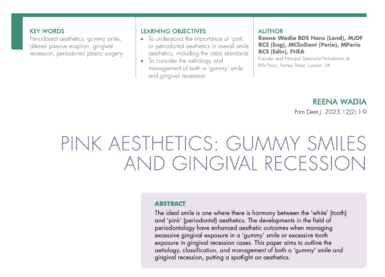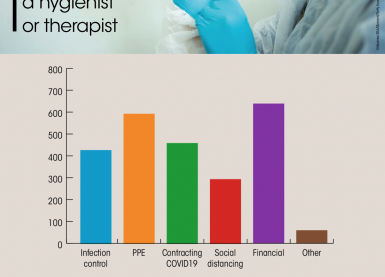Home/Articles
/ General Dental /
Reena’s Notes: Ten Tips on a Team Approach to Periodontal Management with Ian Dunn & Helen Minnery
June 22, 2021

- Team = a group of people with a full set of complimentary skills, required to complete a task/job/project to achieve a common goal. Team work is embedded in the GDC standards under principle 6, which highlights we should “work effectively with colleagues to contribute to good team work” as well as “delegate or refer appropriately and effectively”.
- Good communication is the key to good team work. Try and avoid mixed messages between clinicians. It’s often useful to set time aside during lunch/end of the day/team meetings to discuss cases. If you’re not all singing from the same hymnbook it will look unprofessional in front of patients and you’re more likely to make mistakes.
- Design a protocol for your perio patients in practice where all the team members’ positions in the pathway are clearly identified. Ensure everyone is aware of the scope of practice for each of the team members.
- The obvious dental team members involved with the periodontal management of a patient include: GDP, specialist, dental hygienist/dental therapist, nurse, and receptionist. It’s also important to remember that the patient is part of this team as if they don’t understand their responsibility and comply you are unlikely to achieve good treatment outcomes. The GP may also be part of this team for periodontal patients e.g. may need to check for diabetic status or discuss viability of changing drugs involved in gingival overgrowth.
- The first person the patient will communicate with is usually the receptionist. It’s important that the reception team communicate well with the patient to ensure that all the hard work done in the surgery is not undermined. For example, they shouldn’t say, “you are only here to see the hygienist”. It should be “I see you are here to see our hygienist”. Also “you are only here for a scale and polish” devalues the appointment. It should be “ you are here for your supportive care appointment”.
- Who does what depends on the skill mix in the practice but the workflow is usually under the direction of the person taking responsibility for the patient i.e. usually the dentist but may be hygienist/therapist under Direct Access.
- There has been an important change in the scope of practice to reflect hygienists and therapists ability to diagnose and treatment plan within their competence. Hygienists and therapists are allowed to order, take and interpret radiographs (if they’ve had the appropriate training) but a dentist must still report on any radiographs.
- Screening i.e. the BPE should be carried out by whoever is taking overall responsibility for the patient care. The BPE is pre-diagnostic and not diagnostic and so will require further decisions/actions to be made. Detailed periodontal charting can be carried out by dentist/therapists/hygienists but should ideally be done by the same person before and after treatment to reduce errors.
- When a prescription is made to a hygienist/therapist, include a brief description of what you require as well as the drug, maximum amount and administration route of the LA. Don’t be too prescriptive – allow the hygienist/therapist enough clinical freedom i.e. say “if LA required…” rather than “please use LA”. You are just offering guidance not specific instructions. It’s useful to add some notes beyond the prescription to give the hygienist more information about the patient in general e.g. “4 young children and currently under a lot of stress”. It’s also helpful if the dentists documents and explains to the patient that they may require several appointments with the hygienists and the hygienist will decide the number on their initial visit.
- Referral may be made by a hygienist/therapist/dentist to another team member because of the complexity of the disease e.g. aggressive periodontitis or because of the complexity of patient e.g. complex MH, difficult patient. If you do not feel confident and competent to treat a patient, you must refer to the appropriate person.
These notes were derived from a webinar produced by the British Society of Periodontology. Further resources can be found at: www.bsperio.org.uk.
Learn more by reading some of our other articles here.



